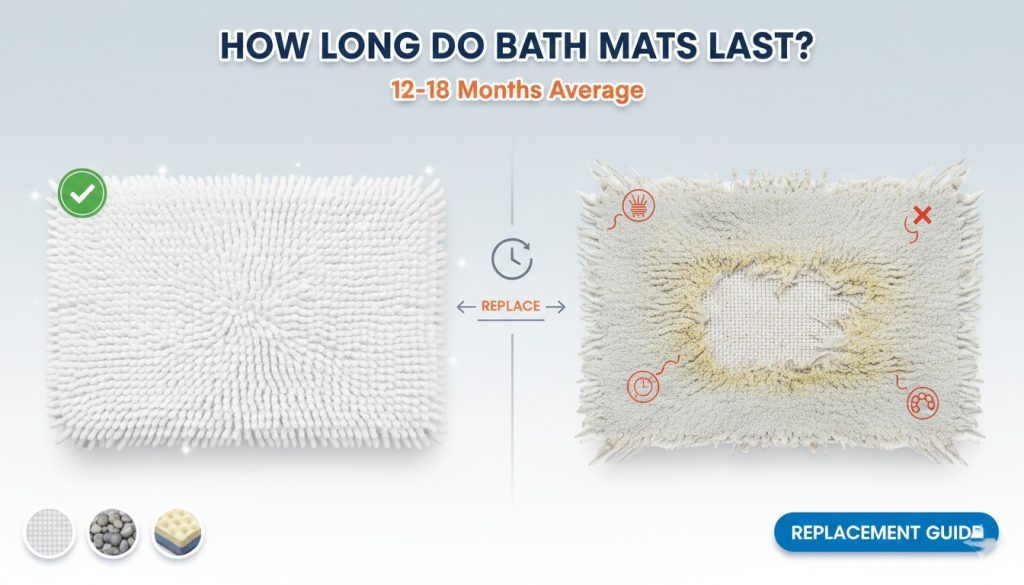
I’ll be honest—I never gave much thought to my bath mats until one morning when I stepped out of the shower and nearly ate it on my bathroom floor. The mat I’d been using for who-knows-how-long had lost all its grip, and that near-wipeout was my wake-up call. Turns out, bath mats aren’t just decorative; they’re safety equipment that wears out faster than most of us realize.
If you’ve ever wondered how long do bath mats last, you’re not alone. After my slippery incident, I went down a rabbit hole of research and real-world testing with different mat types. What I discovered was eye-opening: the lifespan of these bathroom essentials varies wildly depending on material, usage, and how well you care for them. In this guide, I’ll share everything I’ve learned about keeping your bath mats fresh, functional, and—most importantly—safe.
Understanding Bath Mat Longevity by Material Type
Not all bath mats are created equal. I learned this the hard way after cycling through several types over the years, each with its own quirks and lifespan.
Cotton and Fabric Mats
Cotton mats were my go-to for years because they felt cozy underfoot and matched my towels. In my experience, a decent cotton bath mat typically lasts between one to two years with regular use. I had one plush cotton mat in my master bathroom that started showing its age around the 18-month mark—the fibers began thinning in the center where I stood most often, and the edges started fraying despite careful washing.
The lifespan really depends on thread count and construction quality. I once bought a bargain-bin cotton mat that lasted maybe six months before it looked ratty. Compare that to a higher-quality version I splurged on, which held up beautifully for nearly two years before I noticed significant wear.
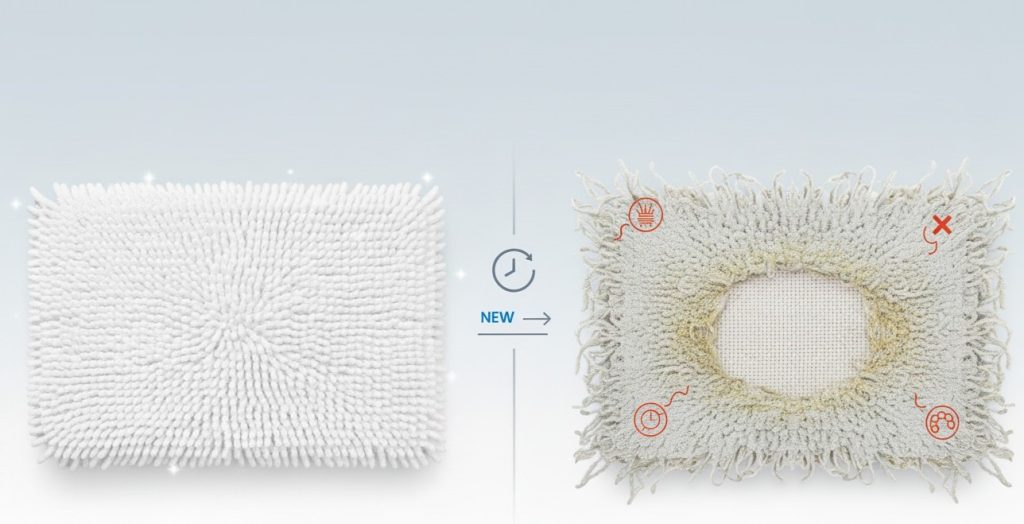
Memory Foam and Microfiber Options
Memory foam mats changed my life—at least for a while. That cushy feeling when you step out of the shower is unbeatable. I’ve found these typically last anywhere from 18 months to three years, depending on quality and how much traffic they see.
My favorite microfiber mat lived in my bathroom for about two years before I noticed the foam core starting to break down. It developed these weird lumpy spots where the foam had compressed unevenly, and the absorbency dropped off noticeably. The microfiber top held up longer than the foam underneath, which is a common pattern I’ve noticed with this style.
Stone and Hard Surface Mats
Here’s where things get interesting. I bought a beautiful diatomaceous earth stone mat about three years ago, excited about the quick-dry promise and modern aesthetic. These mats are marketed as lasting for years—and in some ways, they do. The material itself doesn’t degrade like fabric.
But I quickly discovered warping issues are a real problem with stone mats, especially if your bathroom has temperature fluctuations or if the mat gets bumped around. Mine developed a slight bow within about eight months, which created an unstable surface. I talked to other stone mat owners, and many reported similar experiences. The warping happens because stone is porous and absorbs moisture, then expands and contracts with temperature changes.
My stone mat also developed a crack along one edge after about a year and a half—probably from being propped against the wall to dry one too many times. While the concept is great, the reality is these require more careful handling than you’d expect from something literally made of stone.
Signs It’s Time for a Replacement
I used to be terrible at recognizing when a bath mat had outlived its usefulness. I’d keep using the same mat until my partner staged an intervention. Now I know exactly what to look for.
Visible Deterioration
Wear and tear concerns are usually the first clue that replacement time is approaching. With my cotton mats, I noticed the pile would flatten out in high-traffic spots—right where I step out of the shower every morning. When you can see the backing material through the fibers, it’s definitely time.

Fraying edges are another dead giveaway. I had a gorgeous bath mat that started unraveling at the corners. I trimmed the loose threads a few times, but eventually the fraying spread faster than I could keep up with. That mat became a tripping hazard rather than a safety feature.
Color fading and discoloration tell their own story. I once kept a white bath mat way past its prime because “it still worked fine.” But looking back at photos, it had turned this dingy grayish-yellow that no amount of bleaching could fix. That discoloration isn’t just aesthetic—it signals that the fibers have broken down and can’t be properly cleaned anymore.
Functional Problems
The slipping incident I mentioned earlier? That was the ultimate functional failure. Bath mat backing degrades over time, especially the rubber or latex grips on the bottom. I’ve noticed this happens faster if you’re tossing the mat in the dryer regularly—the heat breaks down those grippy nubs.
Water absorption is another critical function that fails gradually. My microfiber mat used to soak up water instantly, leaving my feet completely dry. Toward the end of its life, I’d step on it and feel water squishing between my toes because the mat just couldn’t absorb anymore. That’s your sign that the material has become saturated with detergent residue, body oils, and mineral deposits that won’t wash out.
And let’s talk about the smell. You know what I mean—that musty, sour odor that lingers even after washing. I fought this battle with one mat for months, trying everything from vinegar soaks to hot water washes with extra rinse cycles. Eventually I realized the mildew had penetrated so deep into the foam core that it was a lost cause.
Hygiene Red Flags
This is where I draw a hard line now. If you’re seeing visible mold or mildew spots that survive a hot wash, the mat needs to go immediately. I once discovered black mold growing on the underside of a mat I hadn’t flipped over in ages. That image is burned into my brain and transformed me into someone who regularly inspects bath mats like a detective.
Stains that won’t budge—especially around the edges where water pools—indicate the material has degraded to the point where contaminants are embedded in the fibers. No amount of scrubbing will get them out because you’re essentially trying to clean something that has broken down at a molecular level.
When to Replace Bath Mats: A Practical Timeline
After years of trial and error (and several premature and overdue replacements), I’ve developed a practical framework for when to replace bath mats based on real-world use.
General Replacement Guidelines
In my master bathroom where I shower daily, I now replace cotton and microfiber mats every 12 to 18 months, regardless of how they look. This might seem excessive, but after that slipping incident, I decided safety and hygiene trump frugality. The mat might still look decent at the one-year mark, but I know the backing and absorption are declining.
My guest bathroom tells a different story. The mat in there sees action maybe twice a month when we have visitors. I’ve had the same high-quality cotton mat in that space for nearly three years, and it still looks and functions like new. Low traffic really does extend lifespan dramatically.
Family size matters enormously. When it was just me and my partner, mats lasted longer. After kids entered the picture, bathroom traffic tripled, and mats started wearing out in half the time. Three people showering daily creates significantly more moisture, friction, and general abuse than one or two people.
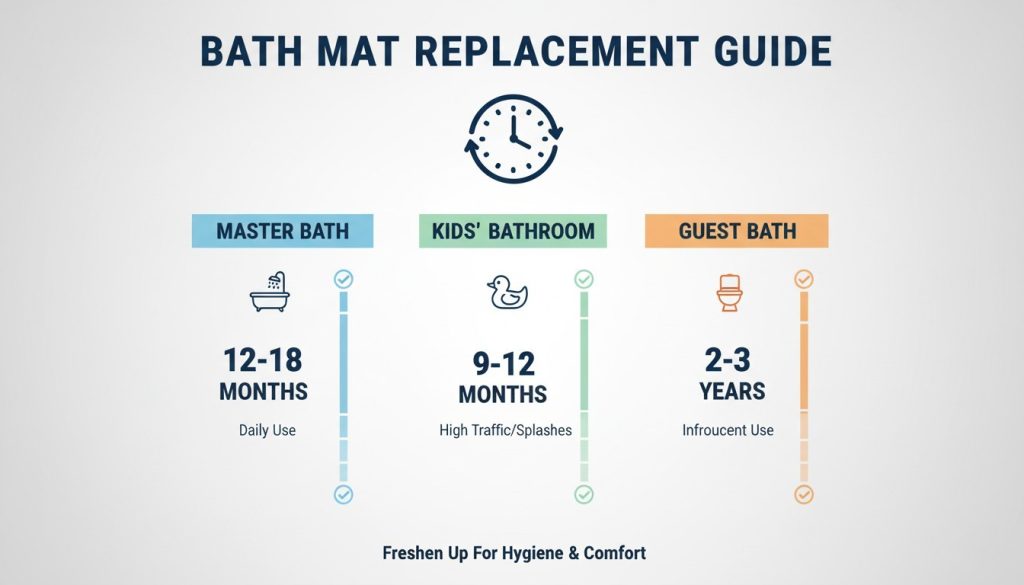
Material-Specific Schedules
Through my various experiments, I’ve landed on these rough guidelines:
Cotton and fabric mats typically need replacing every 12 to 24 months with daily use. The lower end applies to cheaper mats or high-traffic situations; the higher end is for premium mats with light use.
Synthetic materials like microfiber and memory foam tend to last 18 to 30 months. The foam core degrades more slowly than cotton fibers, but when it goes, it goes suddenly. I’ve had memory foam mats that seemed fine one month and then completely collapsed the next.
Stone mats are tricky. Theoretically, they could last for years if the material itself doesn’t degrade. But in practice, I’d plan to replace them every two to three years due to warping and the risk of cracking. That’s been my experience and what I’ve heard from others who’ve tried them.
Usage-Based Indicators
Here’s what I’ve noticed: if you’re showering twice a day (like during hot summer months or after workouts), your mat is experiencing double duty. I now keep two mats that I rotate every few days, which extends their collective lifespan and gives each one time to fully dry out.
Pets add another variable. My dog occasionally parks himself on the bath mat after his own baths, and his nails have definitely accelerated wear on certain mats. If you have pets with bathroom access, shave a few months off your expected replacement timeline.
How Often to Replace Bath Mats in Different Scenarios
Let me break down how often to replace bath mats based on the real scenarios I’ve encountered in my own home and those of friends and family.
High-Use Households
In my house with three daily showers, I’ve found that mats in the main bathroom need replacing every nine to twelve months. That might sound frequent, but consider this: that mat is getting soaked and stepped on at least three times daily, then struggling to dry in a humid environment before the next person showers.
Homes with kids face additional challenges. Children don’t exactly step carefully onto bath mats—they jump, slide, and generally treat them like bathroom playground equipment. My friend with four kids replaces her mats every six to nine months because they take such a beating.
Pet owners should also consider themselves in the high-use category. If your dog drinks from the toilet (no judgment—I’ve been there) or camps out on the bathroom floor, that mat is getting extra wear.
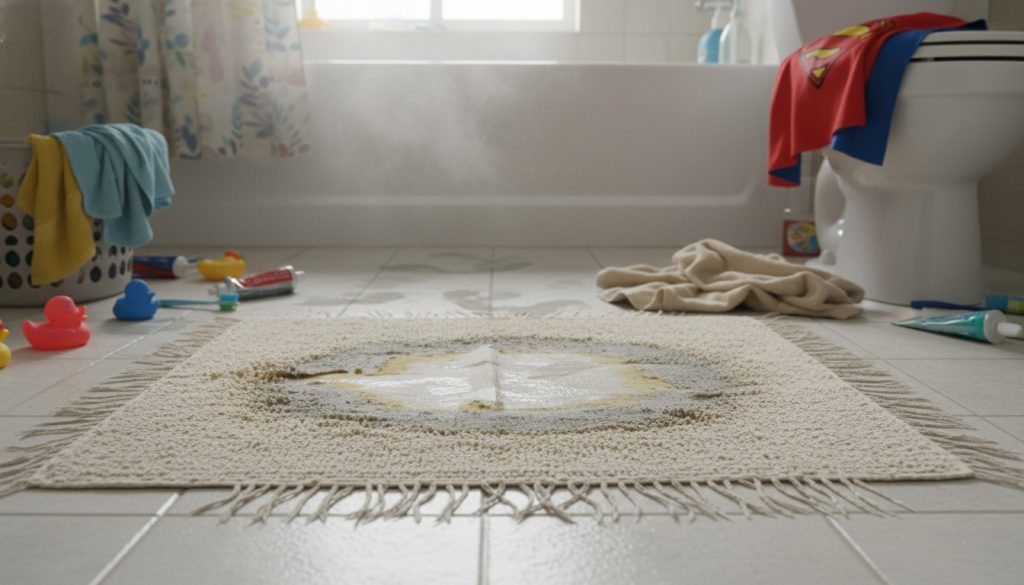
Standard Use Situations
For most people—maybe two people in a household, one shower per person daily—the sweet spot is replacing mats every 12 to 18 months. This gives you good value while ensuring you’re not compromising on safety or hygiene.
I also think seasonally about replacements now. I tend to buy new mats in early fall and late spring, which means each mat serves through roughly two seasons before replacement. This timing helps me remember to actually do it rather than perpetually procrastinating.
Low-Traffic Bathrooms
Guest bathrooms are the overachievers of the bath mat world. The mat in my powder room has been there for almost three years and still looks presentable because it gets used maybe once or twice a week at most.
For these situations, you can push replacement to every two to three years, but I’d still inspect regularly for mildew. Even with light use, bathroom humidity can cause problems. I actually remove the mat from my guest bath when we don’t have visitors coming for a while, storing it in a dry closet to prevent moisture issues.
Extending Your Bath Mat’s Life
I used to think bath mats were low-maintenance—throw them in the wash occasionally, call it good. Turns out, proper care can nearly double their lifespan.
Proper Maintenance Techniques
The biggest game-changer for me was increasing washing frequency. I now wash bathroom mats every week, sometimes more if they’re getting heavy use. I know that sounds excessive, but hear me out: frequent washing prevents the buildup of body oils, soap scum, and moisture that degrade materials faster.
I wash mine in hot water with a small amount of detergent—less than you’d think. Too much detergent leaves residue that actually attracts more dirt and reduces absorbency. I learned this after wondering why my freshly washed mat felt kind of slimy.
Here’s a tip I wish I’d known earlier: skip the fabric softener entirely. It coats the fibers and destroys absorbency. Same goes for dryer sheets. I air dry my mats now, hanging them over the shower rod or outside in nice weather. The dryer’s heat degrades the backing material, which is why I was constantly dealing with slipping mats before.
Between washes, I hang my mat over the tub edge or shower rod to dry completely. This single habit has eliminated the mildew problems I used to battle constantly.
Preventive Measures
Rotation is key. I bought two identical mats for my main bathroom and swap them out every three days. While one is in use, the other is drying completely or in the wash. This strategy has extended the life of both mats significantly because neither is perpetually damp.
For stone mats, I learned the hard way that you need to store them flat and dry. Leaning them against a wall seemed convenient, but that’s what caused my warping issue. I also wipe mine down after each use now, which sounds fussy but takes literally ten seconds and prevents mineral buildup.
Position matters too. I used to place my mat right up against the shower door, which meant it was constantly splashed during showers. Moving it back about six inches—far enough to catch shower drips but not spray—kept it from staying sopping wet all day.
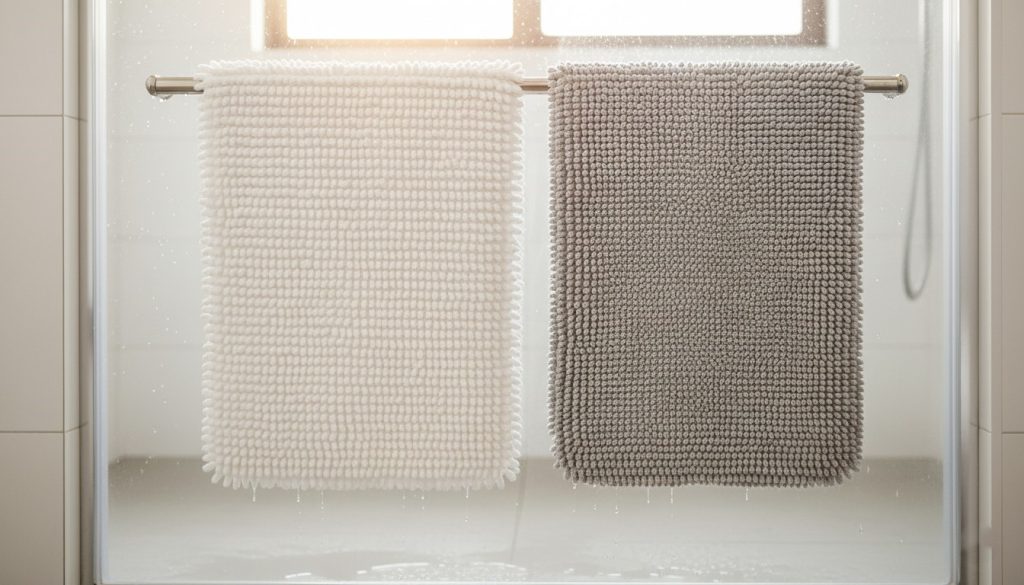
Storage Tips
For seasonal or guest bathroom mats, proper storage prevents that musty smell and potential mildew. I wash and completely dry mats before storing them folded (not rolled—rolling can damage the backing) in a linen closet with good airflow.
I also rotate my everyday mat to a low-traffic bathroom during vacations. No point having it sit wet in an unused bathroom accumulating mildew while we’re away. I’ll bring it back to the main bathroom when we return.
Making Smart Replacement Decisions
After replacing probably two dozen bath mats over the years, I’ve developed strong opinions about what’s worth the investment.
Cost vs. Quality Considerations
I used to buy the cheapest bath mats I could find, figuring they’d all wear out eventually anyway. But here’s the math that changed my thinking: a $10 mat that lasts six months costs more per year than a $30 mat that lasts two years. Plus, the quality mat performs better for its entire lifespan.
That said, you can definitely overspend. I once bought a $70 “luxury” bath mat that looked gorgeous but fell apart within a year because it was all style, no substance. The sweet spot I’ve found is in the $20-$35 range for cotton or microfiber mats. At that price point, you’re getting decent construction without paying for fancy branding.
For stone mats, I’d actually recommend going cheaper unless you’re extremely careful with them. Since warping is such a common issue regardless of quality, spending $60-plus on a stone mat that might develop problems within a year doesn’t make sense to me. But that’s personal preference—some people love them and treat them like delicate bathroom art.
Environmental Factors
I’ll admit, throwing out bath mats used to make me feel guilty. Now I try to repurpose them when possible. Old mats make excellent garage shop rags, pet bedding (after thorough washing), or even garden kneeling pads.
Some areas have textile recycling programs that accept old bath mats. I found one near me that processes them into industrial wiping cloths. It’s not perfect, but it’s better than the landfill.
When shopping for replacements, I’ve started choosing cotton mats over synthetic when possible. They biodegrade eventually and generally use fewer petroleum-based materials in production. Organic cotton options exist, too, though they’re pricier and, in my experience, don’t last significantly longer.
Shopping for Longevity
After all my experimentation, here’s what I look for now:
Thick, dense pile for cotton mats indicates quality construction that’ll hold up longer. If you can easily see through the fibers to the backing in the store, it’s not going to last.
For microfiber mats, I check the thickness and density of the foam core if possible. A thin, flimsy core will compress quickly. The mat should feel substantial in your hands.
Double-stitched edges and reinforced corners resist fraying. I run my finger along edges in the store—if I feel loose threads right away, I skip it.
Rubber backing (as opposed to latex or cheap plastic) tends to maintain its grip longer. It should feel substantial and tacky, not thin and smooth.
Machine washable is non-negotiable. If it requires special care, I’m not buying it. Bath mats need frequent washing to stay hygienic, and hand-washing isn’t realistic for most people.
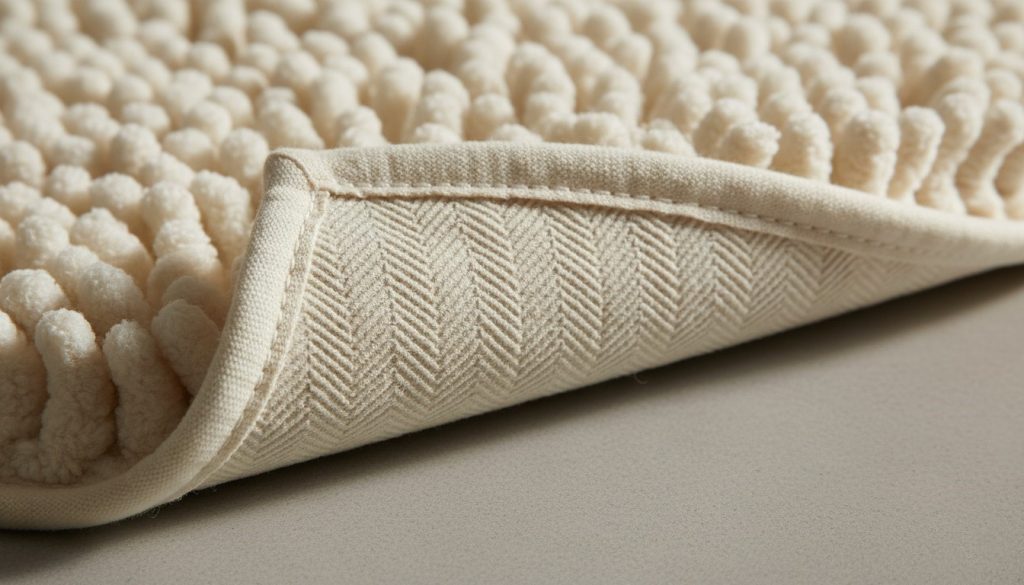
Conclusion
Looking back at my journey from bath mat neglect to bath mat vigilance, I’m honestly amazed at how much this simple bathroom accessory impacts daily life. That near-fall incident taught me that wear and tear concerns aren’t just about aesthetics or even hygiene—they’re about safety.
The question of how long do bath mats last doesn’t have a one-size-fits-all answer, but you now have the framework to assess your specific situation. Whether you’re dealing with a cotton mat showing its age, worried about warping issues with your stone mat, or just wondering how often to replace bath mats in different bathrooms, trust your observations and err on the side of caution.
My advice? Set a reminder on your phone to evaluate your bath mats every six months. Check for the warning signs we discussed, consider your usage patterns, and don’t let guilt about “wasting” a mat keep you using one past its prime. A $25 replacement is a lot cheaper than a trip to the emergency room.
These days, I actually enjoy shopping for new bath mats, knowing I’m making an informed decision rather than grabbing whatever’s on sale. My bathroom feels fresher, safer, and honestly, stepping onto a new, plush bath mat is one of those small luxuries that makes daily life a little better.
Stay safe, stay dry, and don’t ignore those fraying edges.
Leave a Reply